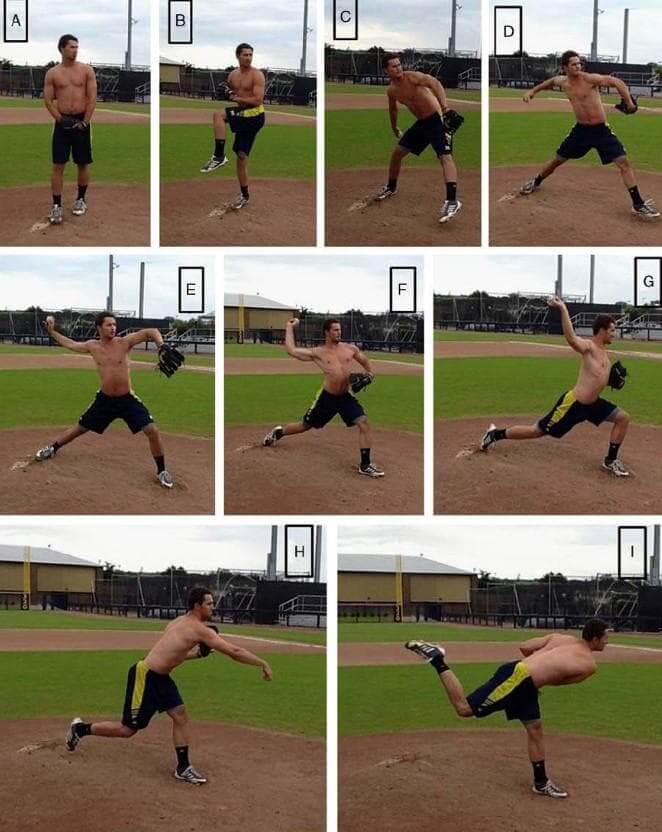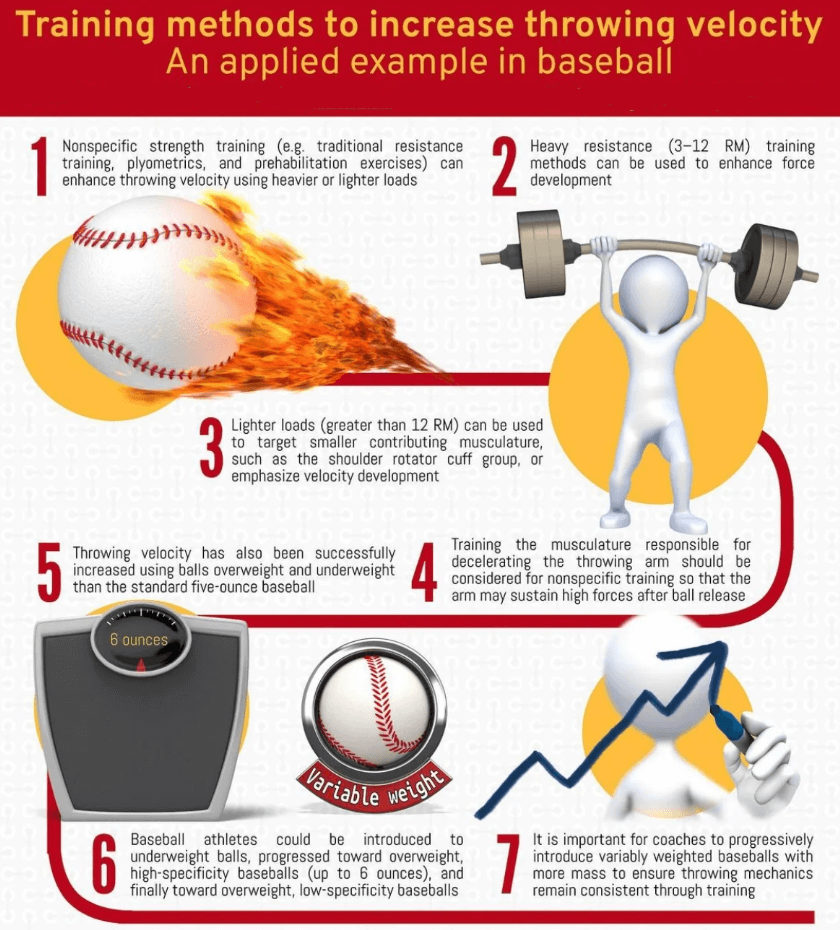Pitching velocity is one of the most important skills in baseball for a pitcher. The speed at which a pitcher can throw the ball has a huge impact on their effectiveness and success. Velocity matters because the faster a pitch is thrown, the less time the batter has to react and make contact. As a result, harder throwers tend to get more strikeouts, allow less contact, and give up fewer hits and runs.
Pitchers generate velocity primarily through mechanics, strength, and athleticism. Proper pitching mechanics allow pitchers to efficiently transfer energy from their lower to upper body in order to maximize the speed at which they can throw the ball. Leg drive, hip rotation, and upper body acceleration are key components. Additionally, overall body strength and power, especially in the legs and core, enables pitchers to apply more force to the baseball. Lastly, athleticism in terms of speed, quickness, and flexibility allows for fluid, explosive movement patterns.
There are several factors that can limit velocity. Poor mechanics lead to inefficient movement, energy leaks, and less than optimal force application. Lack of strength and conditioning limits potential power output. Overuse injuries, poor arm care, and insufficient recovery can also hamper velocity gains. Additionally, proper nutrition and mental conditioning are important to support maximum performance. With deliberate training across all of these areas, pitchers have the potential to enhance their velocity over time.
Mechanics

Proper pitching mechanics are crucial for maximizing velocity. Some key elements include having a strong stable base, getting your whole body involved in the pitching motion, and efficiently transferring energy from the lower to upper body.
Common mechanical mistakes that can reduce velocity include over-rotating the shoulders too early, collapsing the backside, and not getting full extension with the pitching arm. Drills to improve mechanics include staying tall throughout the delivery, doing pause reps at strategic points, and practicing quick hip rotation throws.
To develop clean efficient mechanics, pitchers should focus on repeating their delivery and maintaining balance. High speed video analysis and feedback from knowledgeable coaches are also essential. With proper training and practice, pitchers can optimize their mechanics to maximize ball velocity.
Strength Training

Strength training is crucial for increasing pitching velocity. The key muscle groups to focus on are the legs, core, shoulders and back. Developing power in the legs and core helps generate force from the lower body up through the torso and shoulders to the arm. The shoulders and back provide stability and transfer force to propel the ball forward.
Some of the best weight lifting exercises for pitchers include squats, deadlifts, push presses, and pull-ups. These compound exercises build overall power. Isolation exercises like shoulder raises, rows, and core work further strengthen the pitching muscles. Bodyweight moves like planks, mountain climbers and push-ups can also improve strength with just body weight as resistance.
The key is focusing on total body power and stability through a mix of heavy compound lifts along with targeted isolation work on key muscle groups. A properly designed strength program improves velocity by increasing force generation and transfer efficiency.
Sprint Training

Sprinting is a great way for pitchers to build lower body power and improve elasticity in their muscles and connective tissues. As pitchers drive forward with each pitch, the ability to efficiently transfer force from the legs and hips to the upper body is critical for increasing velocity.
Specific sprint workouts can help pitchers condition their fast-twitch muscle fibers and connective tissues to store and release energy. Some effective sprint routines include sets of 40-60 yard sprints, 10-20 yard bounding drills, and lateral bounds across the mound. High intensity sprints with full rest periods allow pitchers to maintain mechanics and run at max velocity.
Proper warmups are key before any sprint session. Dynamic stretches, leg swings, and buildup runs prepare muscles for powerful contractions. Maintaining good posture and mechanics during sprints reduces injury risk. Pitchers should focus on driving hard with each step, maintaining a neutral spine, and swinging arms to counterbalance leg drive. With focused training, sprint work can directly translate to increased pitching velocity.
Recovery
Adequate recovery between pitching outings is crucial for increasing velocity and avoiding injury. Rest allows the arm to heal from the extreme stresses of pitching. Without proper rest, the arm never fully recovers and velocity will decrease over time.
Sleep is one of the most important recovery tools. Pitchers, especially youth pitchers, need 8-10 hours of sleep per night to allow the body to regenerate. Massage therapy helps promote blood flow and reduce muscle tightness and soreness. Ice baths are also commonly used by pitchers to decrease inflammation.
Overtraining is one of the biggest risks to a pitcher’s health and performance. Throwing too much, too often will lead to fatigue, loss of velocity, and increased injury risk. Follow strict pitch counts and required rest periods. For youth pitchers, guidelines suggest avoiding pitching on consecutive days, taking at least 2 days rest between starts, and resting 3 months out of the year from throwing. Listen to your body and take additional rest when needed. Conditioning and strength training should also be periodized properly to allow for recovery.
Long Toss & Throwing

Long toss is a crucial part of a pitcher’s throwing routine and can help maximize velocity gains when done properly. By progressively increasing the distance of throws, long toss helps build arm strength and endurance. Many MLB pitchers utilize long toss sessions up to 300 feet or more as part of their weekly throwing programs.
It’s important to gradually build up long toss distance over time. Trying to throw too far too soon can risk overuse injuries. Following a structured long toss routine 2-3 times per week allows the arm to adapt and get stronger. Focus on making relaxed, high-arc throws using proper throwing mechanics. Throwing on a line tends to cause more stress on the arm. Cool down with shorter throws after completing the maximum distance throws.
Monitor pitch counts closely, especially for younger pitchers. Generally, avoid throwing more than 30 pitches in a game for ages 8-10, 50 pitches for ages 11-12, and 75 pitches for ages 13-14. Building up too much fatigue can lead to reduced velocity and higher injury risk. Follow medical guidance on appropriate rest days between pitching appearances.
With patience and consistency using long toss combined with proper strength training, pitchers can safely improve arm strength and maximize their pitching velocity.
Nutrition
Proper nutrition is critical for pitchers looking to increase velocity. The right foods and supplements can provide energy, aid recovery, and support velocity gains.
Best Foods and Diet Plans
Pitchers should focus on foods that provide fuel for workouts and recovery. Complex carbs like oats, brown rice, quinoa, and sweet potatoes are excellent choices. Lean protein sources like chicken, fish, eggs, and Greek yogurt help rebuild muscle. Healthy fats like avocados, nuts, olive oil, and salmon supply energy and nutrients. Staying hydrated is also key – water and sports drinks help replace fluids lost while pitching.
Supplements
Research shows creatine can boost pitching velocity by providing muscles with energy. A daily dose of 2-5 grams is recommended. Caffeine may also provide a temporary velocity boost. Always consult a doctor before trying supplements.
Hydration
Dehydration negatively impacts performance and recovery. Drink at least half your body weight in ounces of fluid daily. Increase fluids on pitching days. Sports drinks with electrolytes can replenish what’s lost through sweat. Avoid alcohol and sugary drinks which can dehydrate.
Mental Preparation

Mental preparation is a crucial component of increasing pitching velocity. Pitchers need to develop a velocity mindset, visualize success, and build confidence in order to maximize their potential.
Developing a Velocity Mindset
Pitchers should focus on developing a growth mindset and believe that velocity can be improved through training. Having ambitious velocity goals, a relentless work ethic, and not accepting limits are all part of creating a velocity mindset. This mindset fuels the intense training required to increase velocity.
Visualization and Mental Rehearsal
Visualizing a smooth, powerful, and efficient pitching delivery can help pitchers pre-program the desired motion. Seeing oneself achieving velocity goals in the mind first is an important step to then achieving them physically. Visualization builds confidence and focus before taking the mound.
Confidence and Focus Training
Pitching with velocity requires extreme confidence and focus. Mental training like meditation, positive self-talk, and blocking out distractions can all contribute to heightened confidence and focus during performance. Without confidence in one’s velocity training, it will be difficult to fully apply it during games.
Arm Care
Properly caring for a pitcher’s arm is critical for maintaining velocity and preventing injury. This involves warming up and cooling down correctly, doing strengthening exercises, and monitoring soreness and fatigue.
To prevent injury, pitchers should properly warm up their arms before throwing at full speed. Some good dynamic warm up exercises include arm circles, scapular squeezes, and shoulder rotations using resistance bands. After pitching, a proper cool down is important to flush waste products like lactic acid out of the muscles and tendons. Light jogging, stretching, and ice baths can aid recovery.
Doing band exercises that target the rotator cuff and scapular muscles helps strengthen the many small muscles and connective tissue involved in pitching. Therabands and Flexbars can be used to perform exercises like internal and external rotations in various positions. This shores up structural weaknesses and imbalances that often lead to overuse injuries.
Pitchers also need to carefully monitor for signs of fatigue like decreased velocity, loss of command, and arm soreness. Monitoring rest, ice baths, massage, and days off can help arms recover fully between outings. Fatigued muscles are more prone to injuries, so adequate rest and recovery time is essential.
Conclusion
Increasing pitching velocity requires a comprehensive approach and commitment to training. The main components outlined in this guide focus on mechanics, strength training, sprint work, long toss and throwing, nutrition, mental preparation, and arm care.
To maximize pitching velocity, it’s critical to develop proper mechanics through video analysis and practice. Building strength in the core, legs, and rotator cuff lays a foundation for increased power. Sprint workouts replicate the explosive movement of pitching. Long toss at incremental distances, weighted balls, and regular flat ground throwing further develop arm strength and endurance.
Proper nutrition provides energy and promotes recovery. Mental preparation like visualization and self-talk enhance technique and confidence. Preventative care through routines focused on flexibility, mobility, soft tissue work, and rest ensure health and longevity.
While genetics play a role, dedicating focused time and effort to an integrated velocity training program can add several ticks to your fastball. Consistency over months and years has a cumulative effect. Effort must continue in the offseason. With patience and persistence, significant velocity gains are within reach.








